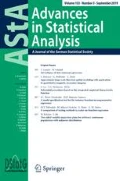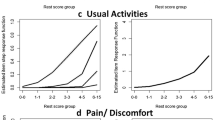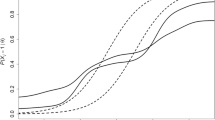Abstract
The subjective assessment of quality of life, personal skills and the agreement with a certain opinion are common issues in clinical, social, behavioral and marketing research. A wide set of surveys providing ordinal data arises. Beside such variables, other common surveys generate responses on a continuous scale, where the variable actual point value cannot be observed since data belong to certain groups. This paper introduces a re-formalization of the recent “Monotonic Dependence Coefficient” (MDC) suitable to all frameworks in which, given two variables, the independent variable is expressed in ordinal categories and the dependent variable is grouped. We denote this novel coefficient with \(\mathrm{MDC}\mathrm{go}\). The \(\mathrm{MDC}\mathrm{go}\) behavior and the scenarios in which it presents better performance with respect to the alternative correlation/association measures, such as Spearman’s \(r_\mathrm{S}\), Kendall’s \(\tau _b\) and Somers’ \(\varDelta \) coefficients, are explored through a Monte Carlo simulation study. Finally, to shed light on the usefulness of the proposal in real surveys, an application to drug-expenditure data is considered.








Similar content being viewed by others
Notes
Boxplots referring to \(n=50\) may be provided upon request.
Even if the JT test is typically used when three or more populations are considered, it can be used for just two populations.
The JT test was led by resorting to the R package “clinfun” which uses the statistic \(JT=\sum _{k<l}\sum _{ij}I(X_{ik}<X_{jl})+0.5I(X_{ik}=X_{jl})\), where i, j are observations in groups k and l, respectively, and \(I(\psi )\) equals one if \(\psi \) is true and zero otherwise. Since the JT test refers to a large sample size (i.e., the values obtained by the indices in 10,000 iterations), the p values provided here are based on normal approximation of the standardized test statistic \(Z=(JT-E(JT))/\sqrt{\mathrm{var}(JT)}\).
References
Agresti, A.: Analysis of Ordinal Categorical Data, 2nd edn. Wiley, New York (2010)
Ahrens, W., Pigeot, I.: Handbook of Epidemiology. Springer, Berlin, Heidelberg (2005)
Aimar, F.: Local reimbursed pharmaceutical expenditure monitoring through the use of statistical tools. Ph.D. Dissertation Thesis, University of Turin (2012)
Bernardini, A.C., Spandonaro, F.: Pharmaceutical Assistance: access to innovation, sustainability and selectivity. 10th Health Report, Chapter 9 (in Italian) (2014)
Blitz, R.C., Brittain, J.A.: An extension of the Lorenz diagram to the correlation of two variables. Metron XXIII(1–4), 137–143 (1964)
Denuit, M., Lambert, P.: Constraints on concordance measures in bivariate discrete data. J. Multivar. Anal. 93, 40–57 (2005)
Ferrari, P.A., Raffinetti, E.: A different approach to Dependence Analysis. Multivar. Behav. Res. 50(2), 248–264 (2015)
Goodman, L.A., Kruskal, W.H.: Measures of association for cross classifications. J. Am. Stat. Assoc. 49, 732–764 (1954)
Hofert, M.: On sampling from the multivariate \(t\) distribution. R J. 5(2), 129–136 (2013)
Jonckheere, A.R.: A distribution-free \(k\)-sample. Tests against ordered alternatives. Biometrika 41, 133–145 (1954)
Kendall, K.: New measure of rank correlation. Biometrika 30(1–2), 81–89 (1938)
Likert, R.: A technique for the measurement of attitudes. Arch. Psychol. 22(140), 5–55 (1932)
Lorenz, M.O.: Methods of measuring the concentration of wealth. Publ. Am. Stat. Assoc. 9(70), 209–219 (1905)
Martin, J., Gonzales, M.P.L., Garcia, D.C.: Review of the literature of the determinants of healthcare expenditure. Appl. Econ. 43, 19–46 (2011)
Marshall, A.W., Olkin, I., Arnold, C.A.: Inequalities: Theory of Majorization and Its Applications, 2nd edn. Springer, Berlin (2011)
Norman, G.: Likert scales, levels of measurement and the law of statistics. Adv. Health Sci. Educ. 15, 625–632 (2010)
OECD: Estimating expenditure by disease, age and gender under the system of health accounts (SHA) framework. Final report. http://www.oecd.org/els/health-systems/EstimatingExpenditurebyDiseaseAgeandGender_FinalReport.pdf (2008). Accessed 15 Mar 2017
Owens, G.M.: Gender differences in health care expenditures, resource utilization, and quality of care. J. Manag. Care Pharm. 14(3 Suppl), 2–6 (2008)
Pearson, K.: Mathematical contributions to the theory of evolution–XVI. In: Pearson, K. (ed.) On Further Methods for Determining Correlation. Draper’s Company Research Memoirs, Biometric Series, vol. IV. Cambridge University Press, Cambridge pp. 1–39 (1907)
Rodgers, J.L., Nicewander, W.A.: Thirteen ways to look at the correlation coefficient. Am. Stat. 42(1), 59–66 (1988)
Roth, M.: On the multivariate t distribution. Report no.: LiTH-ISY-R-3059 (2013)
Schezhtman, E., Yitzhaki, S.: A measure of association based on Gini’s mean difference. Commun. Stat. Theory Methods 16(1), 207–231 (1987)
Somers, R.H.: A new asymmetric measure of association for ordinal variables. Am. Sociol. Rev. 27, 799–811 (1962)
Stuart, A.: The estimation and comparison of strengths of association in contingency tables. Biometrika 40, 105–110 (1953)
Spearman, C.: The proof and measurement of correlation between two things. Am. J. Psychol. 15, 72–101 (1904)
Terpstra, T.J.: The asymptotic normality and consistency of Kendall’s test against trend, when ties are present in one ranking. Indigationes Mathematicae 14, 327–333 (1952)
Acknowledgements
The authors gratefully acknowledge the ASL CN1 of Cuneo (Italy) for making available the dataset representing the case study illustrated and discussed in the paper. A special thanks goes to the Associate Editor and the two anonymous reviewers for their helpful comments and suggestions that allowed to improve the paper.
Author information
Authors and Affiliations
Corresponding author
Rights and permissions
About this article
Cite this article
Raffinetti, E., Aimar, F. MDCgo takes up the association/correlation challenge for grouped ordinal data. AStA Adv Stat Anal 103, 527–561 (2019). https://doi.org/10.1007/s10182-018-00341-1
Received:
Accepted:
Published:
Issue Date:
DOI: https://doi.org/10.1007/s10182-018-00341-1
Keywords
- Grouped ordinal data
- Dependence
- Correlation coefficients
- Association coefficients
- Monte Carlo simulations




